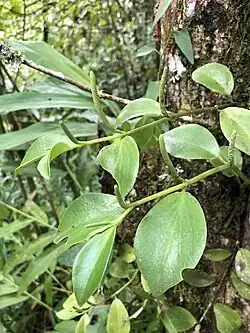Peperomia trianae
| Peperomia trianae | |
|---|---|

| |
| Scientific classification | |
| Kingdom: | Plantae |
| Clade: | Tracheophytes |
| Clade: | Angiosperms |
| Clade: | Magnoliids |
| Order: | Piperales |
| Family: | Piperaceae |
| Genus: | Peperomia |
| Species: | P. trianae
|
| Binomial name | |
| Peperomia trianae | |
| Synonyms | |
| |
Peperomia trianae is a species of epiphyte in the genus Peperomia.[1][2] It primarily grows on wet tropical biomes.[1] Its conservation status is Not Threatened.[3]
Description
The first specimens where collected at 1500 metres elevation on Antioquia.[4]
Change of leaves glabrous on both sides, juniors above and below the principal veins of a leaf, sparsely pubescent, dry, skin-like, sub-pellucid, 7-nerved, catkins opposite, isolated, leaves equal to densiflora, petiolate, subelliptic-lanceolate, apex acute, base subducting into the petiole, rachis foveolate, subglobose fruit, ovary submerged, oval, top flattened, stigmatiferous.[4]
Taxonomy and naming
It was described in 1866 by Casimir de Candolle in "Journal of Botany, British and Foreign.", from collected specimens by José Jerónimo Triana in 1852.[1][5] It gets its name from José Jéronimo Triana.[4]
Distribution and habitat
It is endemic to South America, but primarily grows in Colombia. Its native distribution in Colombia is 1500-3000 metres in the Andes.[1][2] It grows on epiphyte environment and is a herb.[4]
References
- ^ a b c d "Peperomia trianae C.DC". Plants of the World Online. Royal Botanic Gardens, Kew. Retrieved 3 May 2024.
- ^ a b "Peperomia trianae C.DC". Global Biodiversity Information Facility. Retrieved 3 May 2024.
- ^ [1], Angiosperm Extinction Risk Predictions v1
- ^ a b c d "Journal of botany, British and foreign". Retrieved 3 May 2024.
- ^ "Peperomia trianae C.DC". Tropicos. Retrieved 3 May 2024.